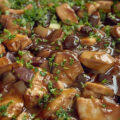Ask any Israeli from ages two to ninety-nine what their favorite comfort food is; you’re likely to hear the same answer every time: Home-cooked Schnitzel.
As a vegetarian myself (especially after the meatless mountains of dismal corn schnitzel I’ve had to endure), I beg to differ. However, my opinion doesn’t negate the millions of Israeli children who look forward to a warm baguette filled with schnitzel and hummus after school. Schnitzel’s ever-evolving nature has helped it become more than just a popular dish to Israelis but a taste of home.
The original schnitzel originated in 19th-century Viennese cuisine with the pounded pork cutlet breaded and fried, also known as the Weinerschnitzel.
It's certainly gone through quite the metamorphosis to what we today call Schnitzel, but without this original creation, we wouldn’t have chicken nuggets or chicken tenders. Ashkenazi Jews had to adapt the dish to the Kosher diet by switching from pork to veal and from clarified butter to oil and schmaltz.
Israeli Schnitzel
With the first waves of Aliyah to Israel in the early 20th century, the pounded veal cutlet had to undergo adaptation yet again. Cattle and agriculture were not readily available to Israelis when they arrived, and a ground-up approach was required. With the lack of veal, they opted for a humbler cut of meat for their beloved Eastern European dish, chicken. It was a natural fit since poultry was far easier, cheaper, and efficient to raise. It was a choice made of necessity rather than desire. But modern Israelis wouldn't have it any other way.
Following the establishment of the State of Israel in 1948, a period arose known as the Tzena, a time of austerity that required rationing food. The new Ministry of Absorption gave new Israeli immigrants cheap rations of chicken and bread mainly, so Schnitzel became one of the only foods readily available to the thousands of new Israelis arriving each day. The Israeli government sent pamphlets on easy dishes to make with the rations; one such dish was chicken schnitzel.
The Tzena only began to quell once the German government started paying reparations for the holocaust to Israeli citizens and Holocaust survivors, helping lead most of them out of abject poverty. Still the sesame seed and breadcrumb-coated chicken breasts only rose in popularity following the Tzena and have largely become a mainstay of Israeli cuisine due to schnitzel’s versatility. It works as a canvas for unique condiments and toppings, which is what many Israeli Schnitzelias have helped do to elevate the simple children’s dish to a genuinely gourmet culinary experience.
Its simplicity is what makes it so comforting. Almost every college kid on a gap year or birthright trip to Israel can remember the healing powers of a schnitzel sandwich after a night of heavy drinking. It's not only an inexpensive means of subsistence, but it also offers a forum for conversation on anything from pop culture to Israel's future and a means of fostering relationships with the other diners at local schnitzel shacks.
In many ways, it’s just an Ashkenazi Milanese, a country-fried steak with chicken or a flattened chicken tender, but those who know know that Schnitzel is so much more than that. Schnitzel is the one food that both Ashkenazim and Sephardim enjoy in tandem. Gefilte fish, chopped liver, and matzah ball soup may be classics in your Bubbe’s house but have never really broken into the Israeli mainstream market and have remained segregated from most Sephardi shabbat tables. This is not the case with Schnitzel; despite being an Eastern European classic, it has found a home in Israel and has wholly been adopted by all of its population. The dish is so popular now that it blurs cultural distinctions and has transcended boundaries of ethnic foods and, in the process, has become something more.
Mel Brooks once expressed his affinity for the dish: “I never eat fried food. I wouldn’t look at it. I don’t touch it. Except once in a while, a little Schnitzel, a few blintzes, a plate of Kreplach.”
From beginning as a dish that nourished Israelis in challenging times to one that connects the millions of Israelis who eat it, Schnitzel has become a critical part of our Israeli culinary identity.



















It wasn't chicken schnitzel it was turkey. Everything was turkey!
I would never have thought to have a schnitzel-and-hummus sandwich. I'm going to have to try that!